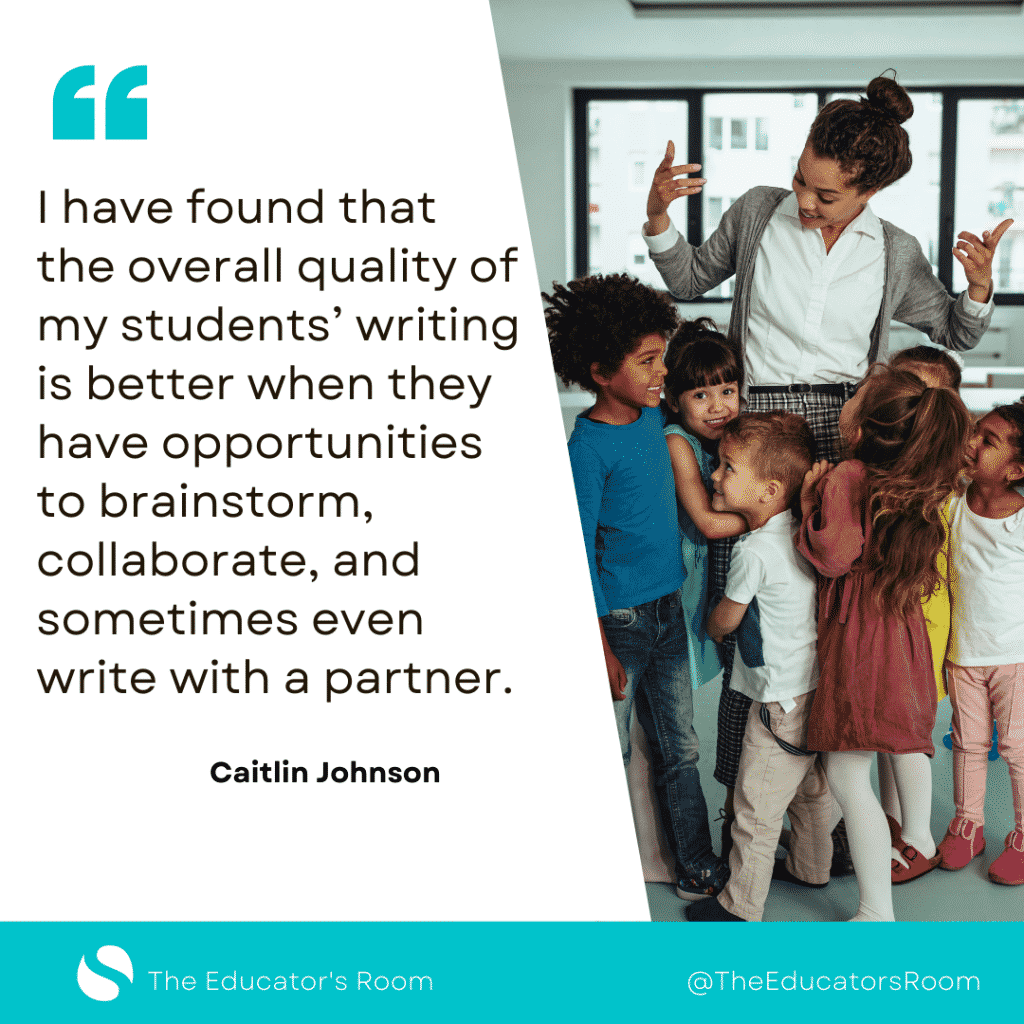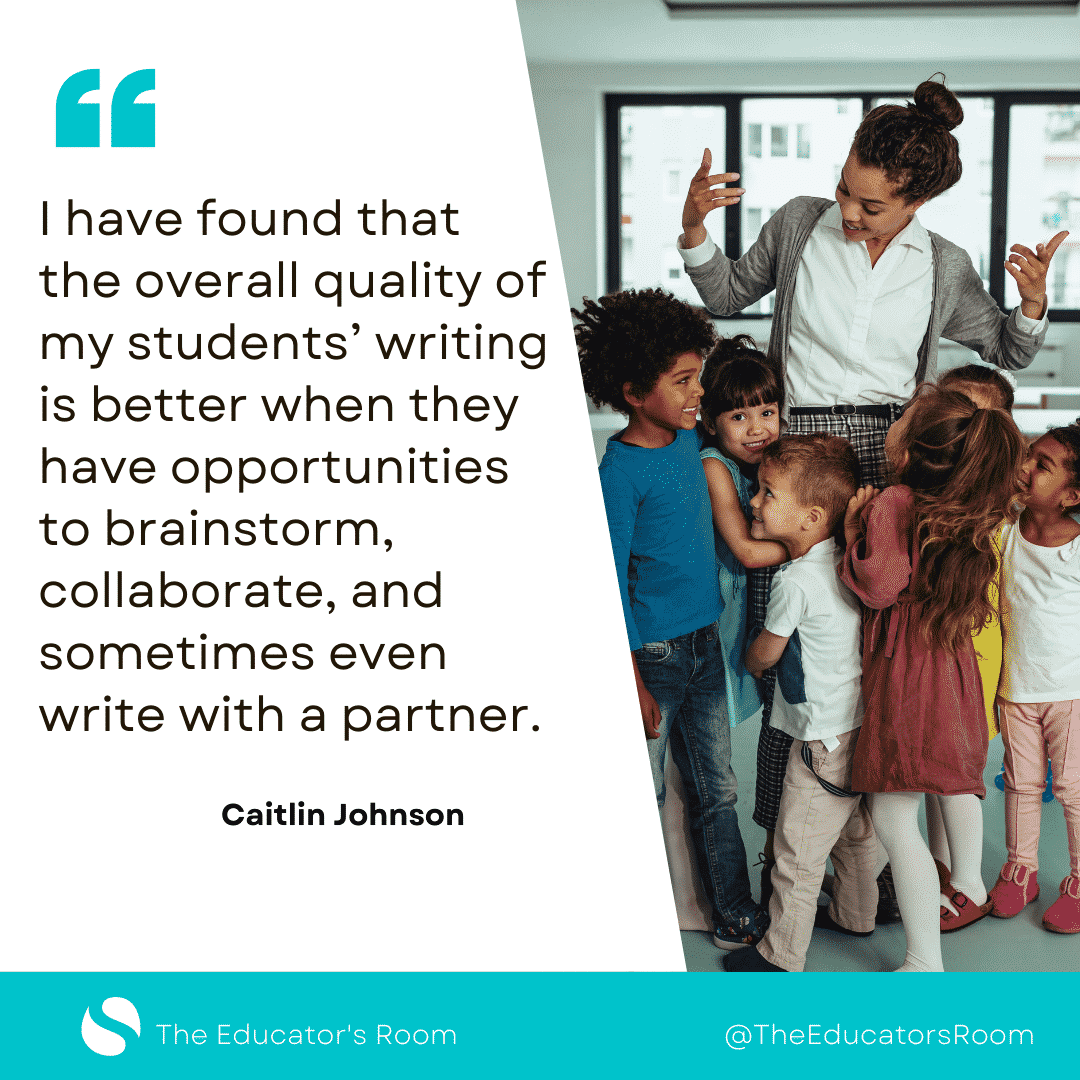Caitlin Johnson is a K-5 teacher of multilingual learners in Minnesota. She loves learning about her students’ cultures and languages. She is currently studying to obtain her master’s degree in literacy education at Concordia University, St Paul.

If you are a teacher, you’ve seen the look of a reluctant writer. You’ve probably witnessed the eye-rolling, crumpling of paper, staring off into space, or playing with an eraser. As an elementary teacher of multilingual learners, (MLs) I have seen my fair share of reluctant writers too. Throw another language into the mix, and a subject that’s already hard becomes even harder. After researching how to engage and support my students with better writing instruction, I would like to share a few instructional scaffolds and strategies that I hope other educators will also find helpful. The best part? Strategies that are best for multilingual learners benefit all students.
Use Graphic Organizers and Sentence Frames
Multilingual learners have the difficult task of learning a new language while also building their content knowledge. One way to support students with this challenge is to provide graphic organizers. Research shows that graphic organizers can reduce the cognitive load for MLs by allowing them to organize information using pictures and words rather than complete sentences during the planning stage of writing (Squire & Clark, 2020). Anytime I assign a writing task, I like to provide a graphic organizer for my students to plan with. Sometimes, we plan our writing together, or sometimes they do it independently. When they use a graphic organizer, I always allow them to draw, write or use a combination of both. I have found that using graphic organizers allows my students to organize their thoughts and understand the genre better, which usually results in better writing.
It can also be helpful to provide sentence frames and word banks during writing. Sentence frames can be a great way to model the type of sentence structure or grammar that you are looking for. They also allow students to focus on the content, rather than getting caught up in having perfect grammar or sentence structure. While they can be beneficial, it’s important not to overdo them. I’ve been guilty of over-scaffolding writing tasks by providing too many sentence frames for students who really didn’t need them. I’ve found that, while they are great for many students, they can sometimes stifle creativity if they are overused.
Provide Explicit Instruction
Explicit instruction on writing conventions, organization, and vocabulary is especially important for multilingual learners (Squire & Clark, 2020). All students, and especially MLs, benefit from having the organization and writing of different genres modeled for them. It is also important to provide explicit vocabulary instruction. The other day, my students were learning about traditions, and how people share their traditions with their communities. For a writing task, I planned to have my students think of and describe a tradition that their family has. I could not assume that they knew what a tradition was, nor could I just spew off a definition then send them on their way to write. It was crucial for me to provide examples and visuals to explain the meaning of the word because I knew that they needed to know it in order to understand and complete the writing task. We often think about the importance of explicit vocabulary instruction for reading, science, and social studies, but sometimes we forget that it is just as important for writing.
Utilize Students’ First Language
Research has shown that we are doing a great disservice to our students if we require them to use only English in the classroom. Rather, we should be providing our MLs with opportunities to utilize their first language in a process called translanguaging. According to researchers Patricia Velasco and Ofelia García (2014), “translanguaging does not view the language of bilinguals as separate linguistic systems. The term stresses the flexible and meaningful actions through which bilinguals select features in their linguistic repertoire in order to communicate appropriately” (p. 7). In other words, we should be celebrating a child’s ability to speak two or more languages, and we should highlight the idea that when we allow them to use their first language in the classroom and in their academic writing, their learning will actually be enhanced.
The idea of translanguaging has been studied by a variety of researchers and is based on the idea that by allowing our students to think, plan and write in their primary language, they will be able to have much more complex thoughts on the topic than if they were restricted to only using English. When they are given permission to use some words in their native language while writing, this helps prevent their thoughts from being interrupted or slowed down because they don’t know how to write something in English. Eventually, they will develop proficiency in English, and they will have more advanced thinking skills that are needed to produce better writing (Velasco & Garcia, 2014). I used to think that as an English teacher, I was supposed to encourage students to always use English. I’ve since learned the importance of allowing them to translanguage, and I don’t just allow them to use their first language in the writing process, I encourage it.
Let Students Talk
Research suggests that learning is social and that students need opportunities to talk with their peers and discuss their writing plans before being required to write (Squire & Clark, 2020). I have found that the overall quality of my students’ writing is better when they have opportunities to brainstorm, collaborate, and sometimes even write with a partner. When they have the chance to express their thoughts out loud before being required to write, this boosts their confidence and motivates them to begin writing. Not only that, but it also gives students a chance to practice their speaking and listening skills as they are communicating with a partner. It also provides an opportunity for some students to practice translanguaging if they are with a partner whose native language is the same as theirs (Squire & Clark, 2020).
Be Careful with the Red Pen.
While it is important to provide constructive feedback on things such as grammar and writing conventions, we need to be careful not to discourage our students by marking up every single error. Researchers Adrienne Wiley and Jonathan McKernan (2017) maintain that when providing feedback to MLs, it is important to focus on content first, than on writing conventions and grammar. They suggest that prior to assigning a writing task, teachers should determine which grammar concepts or conventions they think are most important for that particular task. Maybe it’s using pronouns appropriately, or correctly using past tense verbs. Whatever it is, pick just one or two things that you are going to focus on, and make sure your students are aware of what you will be paying attention to.
Conclusion
A few shifts to our writing instruction can go a long way for the success of our multilingual learners. I hope that you found some of these suggestions to be helpful and that you are inspired to try some of them in your classroom. After all, multilingual learners deserve the support and scaffolds that will allow them to reach their highest potential as writers.

References
McKernan, J., & Wiley, A. (2017). Examining the impact of explicit language instruction in
writers workshop on ELL student writing. The New Educator 13(2), 160-169.
Clark, S.K., & Squire, A. (2020). Exploring how fourth-grade emerging bilinguals learn to write
opinion essays. Literacy Research and Instruction 59(1), 53-77.
García, O., & Velasco, P. (2014). Translanguaging and the writing of bilingual learners.
Bilingual Research Journal 37(1), 6-23. https://doi.org/10.1080/15235882.2014.893270





